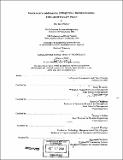| dc.contributor.advisor | Henry D. Jacoby, Gordon M. Kaufman and Gregory J. McRae. | en_US |
| dc.contributor.author | Webster, Mort David | en_US |
| dc.contributor.other | Massachusetts Institute of Technology. Technology, Management, and Policy Program. | en_US |
| dc.date.accessioned | 2005-08-23T15:58:52Z | |
| dc.date.available | 2005-08-23T15:58:52Z | |
| dc.date.copyright | 2000 | en_US |
| dc.date.issued | 2000 | en_US |
| dc.identifier.uri | http://hdl.handle.net/1721.1/8870 | |
| dc.description | Thesis (Ph.D.)--Massachusetts Institute of Technology, Sloan School of Management, Technology, Management, and Policy Program, 2000. | en_US |
| dc.description | Includes bibliographical references (p. 231-240). | en_US |
| dc.description.abstract | The debate over a policy response to global climate change has been and continues to be deadlocked between 1) the view that the impacts of climate change are too uncertain and so any policy response should be delayed until we learn more, and 2) the view that we cannot wait to resolve the uncertainty because climate change is irreversible so we must take precautionary measures now. The objective of this dissertation is to sort out the role of waiting for better information in choosing an appropriate level of emissions abatement activities today under uncertainty. In this dissertation, we construct two-period sequential decision models to represent the choice of a level of emissions abatement over the next decade and another choice for the remainder of this century, both empirical models based on a climate model of intermediate complexity, and analytical dynamic programming models. Using the analytical models, we will show that for learning to have an influence on the decision before the learning occurs, an interaction must be present between strategies in the two decision periods. We define an "interaction" as the dependence of the marginal cost or marginal damage of the future decision on today's decision. When an interaction is present and is uncertain, the ability to learn will introduce a bias in the optimal first period strategy, relative to the optimal strategy if the uncertainty would never be reduced. In general, the bias from learning can be either in the direction of higher or lower emissions, depending on the sign of the interaction and the probability distribution over damage losses relative to abatement costs. | en_US |
| dc.description.abstract | (cont.) We demonstrate using the empirical climate decision models that the difference between optimal emissions abatement today with and without learning is insignificant. The reason is that the IGSM, like most other climate assessment models, omit many of the most important interactions between emissions today and marginal costs or damages in the future. We show that by representing possible interactions, such as induced innovation from policy constraint or the effect of emissions growth on ocean circulation, that learning will have an influence on today's decision, often in the direction of lower emissions if we expect to learn. In general, the "wait-to- learn" is not necessarily a valid argument for delaying a climate policy that constrains emissions. | en_US |
| dc.description.statementofresponsibility | by Mort David Webster. | en_US |
| dc.format.extent | 240 p. | en_US |
| dc.format.extent | 21779590 bytes | |
| dc.format.extent | 21779345 bytes | |
| dc.format.mimetype | application/pdf | |
| dc.format.mimetype | application/pdf | |
| dc.language.iso | eng | en_US |
| dc.publisher | Massachusetts Institute of Technology | en_US |
| dc.rights | M.I.T. theses are protected by copyright. They may be viewed from this source for any purpose, but reproduction or distribution in any format is prohibited without written permission. See provided URL for inquiries about permission. | en_US |
| dc.rights.uri | http://dspace.mit.edu/handle/1721.1/7582 | |
| dc.subject | Technology, Management, and Policy Program. | en_US |
| dc.title | Uncertainty and learning in sequential decision-making : the case of climate policy | en_US |
| dc.type | Thesis | en_US |
| dc.description.degree | Ph.D. | en_US |
| dc.contributor.department | Technology and Policy Program | |
| dc.contributor.department | Sloan School of Management | |
| dc.identifier.oclc | 48764116 | en_US |
